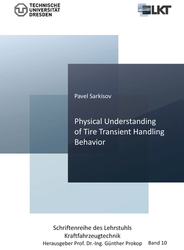| Fachbereiche | |
|---|---|
| Buchreihen (96) |
1378
|
| Nachhaltigkeit |
3
|
| Gesundheitswesen |
1
|
| Geisteswissenschaften |
2365
|
| Naturwissenschaften |
5406
|
| Ingenieurwissenschaften |
1793
|
| Allgemeine Ingenieurwissenschaften | 292 |
| Maschinenbau und Verfahrenstechnik | 862 |
| Elektrotechnik | 686 |
| Bergbau- und Hüttenwesen | 30 |
| Architektur und Bauwesen | 75 |
| Allgemein |
98
|
|
Leitlinien Unfallchirurgie
5. Auflage bestellen |
|
Erweiterte Suche
Physical Understanding of Tire Transient Handling Behavior (Band 10)
Pavel Sarkisov (Autor)Vorschau
Leseprobe, PDF (2,5 MB)
Inhaltsverzeichnis, PDF (530 KB)
Increasing vehicle performance requirements and virtualization of its development process require more understanding of physical background of tire behavior, especially in transient rolling conditions with combined slip. The focus of this research is physical description of transient generation of tire lateral force and aligning torque. Using acceleration measurement on the tire inner liner it was observed that the contact patch shape of the rolling tire changes nonlinearly with slip angle and becomes asymmetric. Optical measurement outside and inside the tire has clarified that carcass lateral bending features both shear and rotation angle of its cross-sections. A physical simulation model was developed, which considers the observed effects. A special iterative computing algorithm was proposed. The model was qualitatively validated using not only tire force and torque responses, but also deformation of the tire carcass. The model-based analysis explained which tire structural parameters are responsible for which criteria of tire performance. Contact patch shape change had a low impact on lateral force and aligning torque. Variation of carcass bending behavior perceptibly influenced aligning torque generation. As an example, the gained understanding was applied for feasibility analysis of a novel method to estimate the utilized friction potential rate of a rolling tire.
| ISBN-13 (Printausgabe) | 9783736970137 |
| ISBN-13 (E-Book) | 9783736960138 |
| Buchendformat | A5 |
| Sprache | Englisch |
| Seitenanzahl | 184 |
| Umschlagkaschierung | matt |
| Auflage | 1. |
| Buchreihe | Schriftenreihe des Lehrstuhls Kraftfahrzeugtechnik |
| Band | 10 |
| Erscheinungsort | Göttingen |
| Promotionsort | Dresden |
| Erscheinungsdatum | 14.05.2019 |
| Allgemeine Einordnung | Dissertation |
| Fachbereiche |
Fahrzeugtechnik
|
| Schlagwörter | physical tire model, tire handling, tire transient behavior, relaxation length, tire carcass lateral bending, contact patch shape, Timoshenko beam, brush model, physikalisches Reifenmodell, Fahrdynamik, transientes Verhalten, Einlauflänge, Durchbiegung der Reifenkarkasse, Latschform, Timoshenko Balken, Bürstenmodell |
| URL zu externer Homepage | https://tu-dresden.de/bu/verkehr/iad/kft |








